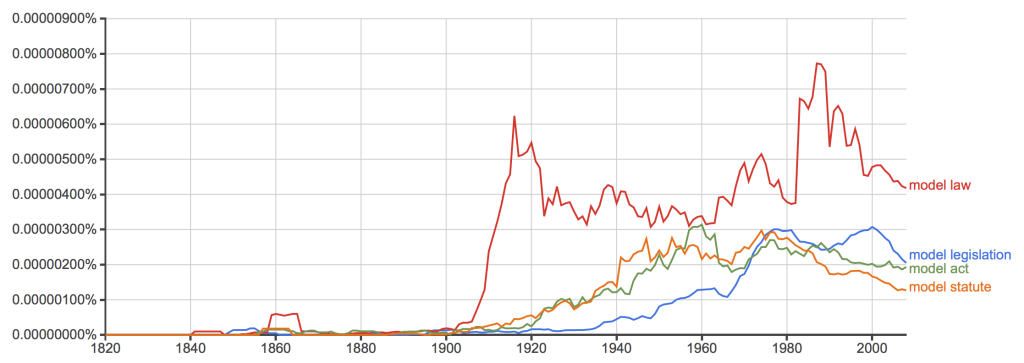This post originally appeared at the Legislation Law Prof Blog
A while back, we noted a forthcoming article by Alexander Hertel-Fernandez, which asked who passes business’s model laws. We’ve been keeping our eyes out for other writing on model laws, and later this week we’ll share a few recent articles.
First, though, it’s worth remembering that despite the recent wave of media and scholarly interest, the model law is hardly a new tool of governance. The graph below shows appearances of “model law” and some variations of the term, in books published since 1820 (and subsequently scanned by Google).
The meaning of “model law” during its first blip, around 1860, is generally different than current usage. Back then, “model law” referred to everything from a law that set the model for the Catholic church to a law seen as exemplary, but not intended to be replicated.
The rise of the model law as a mode of governance appears to have come in the Progressive Era, around 1910. In that year, the Russell Sage Foundation published a model tenement house law, and by 1912 the annual meeting of the Association of Life Insurance Presidents included a report on progress of a model law on the registration of vital statistics.
What isn’t reflected in the graph is that these social reformers and business associations were picking up on a movement for uniformity that got rolling a couple decades earlier. According to the official history of the Uniform Law Commission, the founding meeting of the American Bar Association in 1878 called for greater uniformity of state laws. By 1892, the Commission had been founded as a special committee of the ABA, and in that year, the Commission recommended its first three acts, one on the topic of acknowledgements, and two on wills and estates.
Uniformity was a hit, and the fever for model laws soon spread well beyond the ABA. By 1920 associations and reformers were circulating model laws for civil service, morbidity reports, weights and measures, and juvenile courts – and calling for more, to regulate everything from corporations to indoor ventilation. It was off to the races.
Later this week, we’ll highlight a few recent articles that give a sense of where the American passion for the model law has come, and how they are now being used to govern everything from abortion to farming, consumer protection to the right to counsel.

